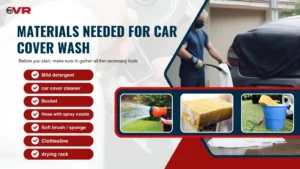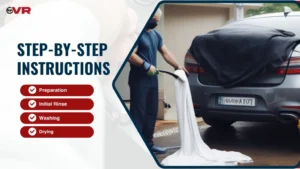A car cover is a worthy investment to protect your vehicle from the elements, harmful UV rays, and environmental pollutants. However, for it to effectively safeguard your car, you have to ensure it’s in a clean state, which includes regular car cover washing to maintain its protective qualities.
A dirty cover could trap dirt, grime, and moisture, leading to scratches, mold, and mildew. It could damage the Cover itself and also your car’s finish. Regular cleaning of the car cover would ensure it delivers the best protection.
This comprehensive guide will walk you through the steps to effectively wash and care for your car cover at home.
Materials Needed

- Mild detergent or car cover cleaner
- Bucket
- Hose with a spray nozzle
- Soft brush or sponge
- Clothesline or drying rack
Step-by-Step Instructions

Preparation
- Check the Label: Before you start, check the care label on your car cover. Some covers are machine washable, while others require hand washing. Follow the manufacturer’s instructions to avoid damaging the Cover.
- Choose the Right Detergent: Use a mild detergent free from bleach or harsh chemicals. Specialized car cover cleaners are also available and can be a good option.
Initial Rinse
- Place the Cover on the Car: For ease of cleaning, place the Cover on your car. This will help you rinse off loose dirt and debris more effectively.
- Rinse with Water: Use a hose with a spray nozzle to rinse the Cover thoroughly. This will remove loose dirt, dust, and bird droppings. Make sure to rinse both the top and underside of the Cover.
Washing
- Prepare the Cleaning Solution: Fill a bucket with cold or warm water and add a small amount of mild detergent. Mix the solution until it is well combined.
- Scrub the Cover: Dip a soft brush or sponge into the cleaning solution and gently scrub the Cover. Focus on areas with stains or heavy dirt buildup. Avoid using excessive force to prevent damaging the fabric.
- Rinse Thoroughly: After scrubbing, rinse the Cover thoroughly with the hose to remove all soap residue. Make sure to rinse both sides of the Cover.
Drying
Hang the Cover on a clothesline or drying rack in a shaded area. Avoid direct sunlight, as it can cause the fabric to fade or weaken. Ensure the Cover is completely dry before storing it to prevent mold and mildew growth.
Additional Tips for Car Cover Cleaning
- Avoid Using a Washing Machine: Most car covers are not designed to withstand the agitation of a washing machine. Hand washing is the safest method.
- Do Not Use Fabric Softener: Fabric softeners can leave residues that attract dirt and reduce the Cover’s effectiveness.
- Regular Maintenance: Shake out your car cover regularly to remove dust and debris. Spot clean any stains as soon as they occur to prevent them from setting in.
Proper Storage Methods to Prevent Damage
- Dry and Cool Environment: Store your car cover in a cool, dry place away from direct sunlight, moisture, and extreme temperature fluctuations.
- Avoid Folding: Folding can create creases and weaken the fabric over time. Hang the Cover on a sturdy hanger or roll it loosely.
- Protect from Pests: Store the Cover in a sealed container or bag to prevent damage from rodents, insects, or other pests.
Inspecting the Car Cover for Wear and Tear
- Regular Checks: Inspect your car cover for signs of wear and tear before each use. Look for holes, tears, fading, or weakened areas.
- Check for Debris: Remove any dirt, dust, or debris from the Cover before storing it.
- Repair or Replace: If you find minor damage, you can repair it with a sewing kit. However, if the damage is extensive, it’s best to replace the Cover.
When to Replace a Car Cover
- Signs of Wear: If the Cover is showing significant signs of wear and tear, such as large holes, fading, or cracking, it’s time for a replacement.
- Loss of Effectiveness: If the Cover no longer provides adequate protection from the elements, it’s time to invest in a new one.
- Outdated Material: If the Cover’s material is no longer suitable for your climate or car type, consider upgrading to a more appropriate cover.
Understanding Car Cover Materials
- Polyester: Known for its durability, water resistance, and affordability.
- Cotton: Soft and breathable but prone to mildew and shrinkage.
- Fleece: Soft and plush, offering excellent protection against scratches, but less durable than other materials.
- Vinyl: Waterproof and durable, but can be noisy and may trap moisture.
- Multi-Layer: Combines different materials for enhanced protection and features.
Care Instructions Specific to Each Material
- Polyester: Machine washable, air dry, or low-temperature tumble dry.
- Cotton: Hand wash or machine wash on a gentle cycle of air drying to prevent shrinkage.
- Fleece: Machine washable on a gentle cycle, air dry or low-temperature tumble dry.
- Vinyl: Wipe clean with a damp cloth; avoid harsh chemicals.
- Multi-Layer: Follow care instructions for the primary material.
Pros and Cons of Different Materials
- Polyester: Durable, water-resistant, affordable, but may not be as soft as other materials.
- Cotton: Soft, breathable, but prone to mildew, shrinkage, and less durable.
- Fleece: Soft, protects against scratches, but less durable and may attract dirt.
- Vinyl: Waterproof, durable, but noisy, may trap moisture, and can be less breathable.
- Multi-Layer: Offers a combination of benefits but can be more expensive.
Car cover washing at home is a simple process that can extend the life of the Cover and ensure your vehicle remains protected. By following these steps and using the right materials, you can keep your car cover clean and in good condition.
Read More: Wash Your Car at Home
Frequently Asked Questions
1) Can I use a washing machine to wash my car cover?
While some car covers are machine washable, it’s generally recommended to hand wash for better care. Always check the care label.
2) What if my car cover has a stain?
For stubborn stains, you can pre-treat the area with a stain remover before car cover washing. Test the stain remover in a small, inconspicuous area first to ensure it doesn’t damage the fabric.
3) How often should I wash my car cover?
The frequency depends on the environment and usage. Generally, washing it once or twice a year is sufficient. However, if it gets heavily soiled, you may need to clean it more often.
4) Can I use bleach on my car cover?
No, bleach can damage the fabric of your car cover. Use mild detergent instead.
5) What should I do if my car cover gets wet while it is in the car?
Remove the Cover as soon as possible and allow it to dry completely to prevent mold and mildew growth.







Leave a Reply